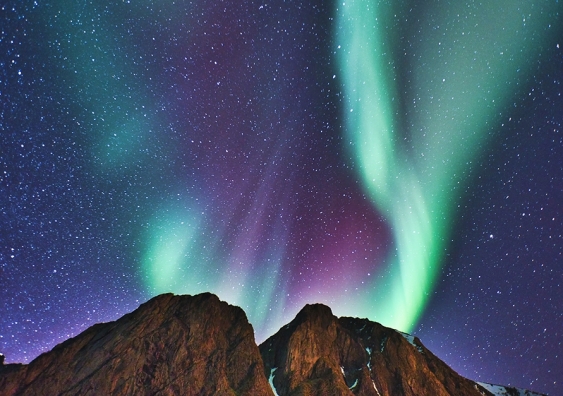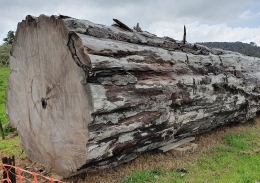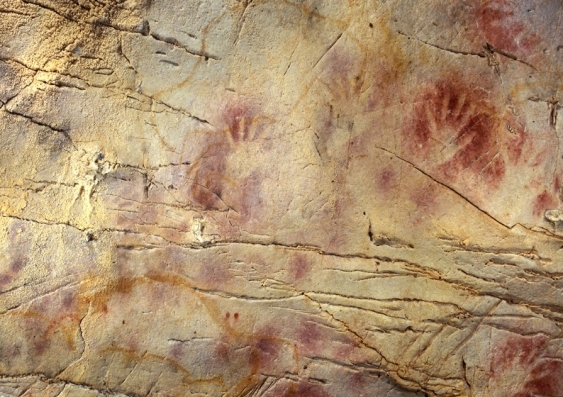Ancient relic points to a turning point in Earth's history 42,000 years ago
Just like in The Hitchhiker’s Guide to the Galaxy, the answer was 42.
Just like in The Hitchhiker’s Guide to the Galaxy, the answer was 42.

Sherry Landow
News & Content Producer
(02) 9065 4039
s.landow@unsw.edu.au
The temporary breakdown of Earth’s magnetic field 42,000 years ago sparked major climate shifts that led to global environmental change and mass extinctions, a new international study co-led by UNSW Sydney and the South Australian Museum shows.
This dramatic turning point in Earth’s history – laced with electrical storms, widespread auroras, and cosmic radiation – was triggered by the reversal of Earth’s magnetic poles and changing solar winds.
The researchers dubbed this danger period the ‘Adams Transitional Geomagnetic Event’, or ‘Adams Event’ for short – a tribute to science fiction writer Douglas Adams, who wrote in The Hitchhiker's Guide to the Galaxy that ‘42’ was the answer to life, the universe, and everything.
The findings are published today in Science.
“For the first time ever, we have been able to precisely date the timing and environmental impacts of the last magnetic pole switch,” says Chris Turney, a professor at UNSW Science and co-lead author of the study.

This ancient kauri tree found in Ngāwhā, New Zealand, was alive during the Adams Event. Photo: Nelson Parker (www.nelsonskaihukauri.co.nz)
“The findings were made possible with ancient New Zealand kauri trees, which have been preserved in sediments for over 40,000 years.
“Using the ancient trees we could measure, and date, the spike in atmospheric radiocarbon levels caused by the collapse of Earth’s magnetic field.”
While scientists already knew the magnetic poles temporarily flipped around 41-42,000 years ago (known as the ‘Laschamps Excursion’), they didn’t know exactly how it impacted life on Earth – if at all.
But the researchers were able to create a detailed timescale of how Earth’s atmosphere changed over this time by analysing rings on the ancient kauri trees.
Read more: Earth's magnetic field broke down 42,000 years ago and caused massive sudden climate change
“The kauri trees are like the Rosetta Stone, helping us tie together records of environmental change in caves, ice cores and peat bogs around the world,” says co-lead Professor Alan Cooper, Honorary Researcher at the South Australian Museum.
The researchers compared the newly-created timescale with records from sites across the Pacific and used it in global climate modelling, finding that the growth of ice sheets and glaciers over North America and large shifts in major wind belts and tropical storm systems could be traced back to the Adams Event.
One of their first clues was that megafauna across mainland Australia and Tasmania went through simultaneous extinctions 42,000 years ago.
“This had never seemed right, because it was long after Aboriginal people arrived, but around the same time that the Australian environment shifted to the current arid state,” says Prof. Cooper.
The paper suggests that the Adams Event could explain a lot of other evolutionary mysteries, like the extinction of Neandertals and the sudden widespread appearance of figurative art in caves around the world.
“It’s the most surprising and important discovery I’ve ever been involved in,” says Prof. Cooper.
Watch as Stephen Fry brings to life the story of the 'Adams event'. Video: UNSW Sydney.
The magnetic north pole – that is, the direction a compass needle points to – doesn’t have a fixed location. It usually wobbles close to the North Pole (the northern-most point of Earth’s axis) over time due to dynamic movements within the Earth’s core, just like the magnetic south pole.
Sometimes, for reasons that aren’t clear, the magnetic poles’ movements can be more drastic. Around 41,000-42,000 years ago they swapped places entirely.
“The Laschamps Excursion was the last time the magnetic poles flipped,” says Prof. Turney. “They swapped places for about 800 years before changing their minds and swapping back again.”
Until now, scientific research has focused on changes that happened while the magnetic poles were reversed, when the magnetic field was weakened to about 28 per cent of its present-day strength.
But according to the team’s findings, the most dramatic part was the lead-up to the reversal, when the poles were migrating across the Earth.
“Earth’s magnetic field dropped to only 0-6 per cent strength during the Adams Event,” says Prof. Turney.
“We essentially had no magnetic field at all – our cosmic radiation shield was totally gone.”
During the magnetic field breakdown, the Sun experienced several ‘Grand Solar Minima’ (GSM), long-term periods of quiet solar activity.
Even though a GSM means less activity on the Sun’s surface, the weakening of its magnetic field can mean more space weather – like solar flares and galactic cosmic rays – could head Earth’s way.
“Unfiltered radiation from space ripped apart air particles in Earth’s atmosphere, separating electrons and emitting light – a process called ionisation,” says Prof. Turney.
“The ionised air ‘fried’ the Ozone layer, triggering a ripple of climate change across the globe.”

From auroras to lightning storms, the sky would have put on quite a show during the Adams Event. Photo: Unsplash.
Dazzling light shows would have been frequent in the sky during the Adams Event.
Aurora borealis and aurora australis, also known as the northern and southern lights, are caused by solar winds hitting the Earth’s atmosphere.
Usually confined to the polar northern and southern parts of the globe, the colourful sights would have been widespread during the breakdown of Earth’s magnetic field.
“Early humans around the world would have seen amazing auroras, shimmering veils and sheets across the sky,” says Prof. Cooper.
Ionised air – which is a great conductor for electricity – would have also increased the frequency of electrical storms.
“It must have seemed like the end of days,” says Prof. Cooper.
The researchers theorise that the dramatic environmental changes may have caused early humans to seek more shelter. This could explain the sudden appearance of cave art around the world roughly 42,000 years ago.
“We think that the sharp increases in UV levels, particularly during solar flares, would suddenly make caves very valuable shelters,” says Prof. Cooper. “The common cave art motif of red ochre handprints may signal it was being used as sunscreen, a technique still used today by some groups.
“The amazing images created in the caves during this time have been preserved, while other art out in open areas has since eroded, making it appear that art suddenly starts 42,000 years ago.”

The centre of this cave art from El Castillo Cave in Spain is believed to be almost 42,000 years old – the same age as the Adams Event. Photo: Paul Pettitt, courtesy Gobierno de Cantabria.
These findings come two years after a particularly important ancient kauri tree was uncovered at Ngāwhā, Northland.
The massive tree – with a trunk spanning over two and a half metres – was alive during the Laschamps.
“Like other entombed kauri logs, the wood of the Ngāwhā tree is so well preserved that the bark is still attached,” says UNSW’s Dr Jonathan Palmer, a specialist in dating tree-rings (dendrochronology). Dr Palmer studied cross sections of the trees at UNSW Science’s Chronos 14Carbon-Cycle Facility.
Using radiocarbon dating – a technique to date ancient relics or events – the team tracked the changes in radiocarbon levels during the magnetic pole reversal. This data was charted alongside the trees’ annual growth rings, which acts as an accurate, natural timestamp.
The new timescale helped reveal the picture of this dramatic period in Earth’s history. The team were able to reconstruct the chain of environmental and extinction events using climate modelling.
“The more we looked at the data, the more everything pointed to 42,” says Prof. Turney. “It was uncanny.
“Douglas Adams was clearly on to something, after all.”
The ancient kauri trees were key to the findings, explain Prof. Chris Turney and Prof. Alan Cooper. Video: UNSW Sydney.
While the magnetic poles often wander, some scientists are concerned about the current rapid movement of the north magnetic pole across the Northern Hemisphere.
“This speed – alongside the weakening of Earth’s magnetic field by around nine per cent in the past 170 years – could indicate an upcoming reversal,” says Prof. Cooper.
“If a similar event happened today, the consequences would be huge for modern society. Incoming cosmic radiation would destroy our electric power grids and satellite networks.”
Prof. Turney says the human-induced climate crisis is catastrophic enough without throwing major solar changes or a pole reversal in the mix.
“Our atmosphere is already filled with carbon at levels never seen by humanity before,” he says. “A magnetic pole reversal or extreme change in Sun activity would be unprecedented climate change accelerants.
“We urgently need to get carbon emissions down before such a random event happens again.”
This work was made possible by funding from an Australian Research Council Discovery Project Grant, support from Ngāpuhi iwi and Top Energy, the University of Waikato Radiocarbon Laboratory, and many other national and international partners.